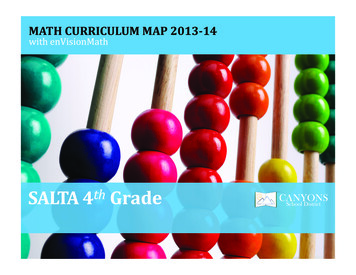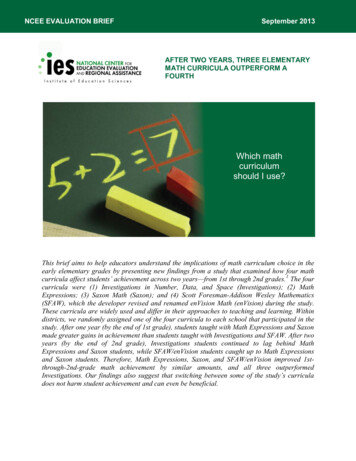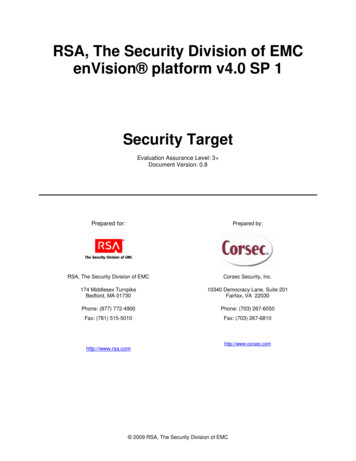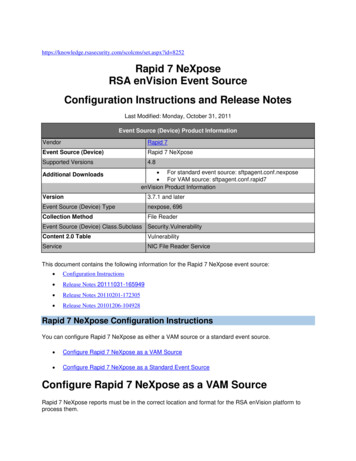
Transcription
FOURTH GRADE ENVISION MATH CURRICULUM MAPCANYONS SCHOOL DISTRICT2013 – 2014Curriculum Mapping PurposeCanyons School District’s curriculum math maps are standards-based maps driven by the Common Core StateStandards and implemented using Scott Foresman-Addison Wesley enVisionMATH 2011. Studentachievement is increased when both teachers and students know where they are going, why they are goingthere, and what is required of them to get there. To that end, curriculum maps answer these questions:REVIEW, CORE, EXTEND, ASSESSWhat do students know?COMMON CORE STANDARDWhat concepts and skills dostudents need to know?ENVISION LESSONHow will students learn thestandards?VOCABULARY & NOTESWhat vocabulary is necessary fordepth of understanding?Curriculum Maps are a tool for: ALIGNMENT: Provides support and coordination between concepts, skills, standards, curriculum, andassessments COMMUNICATION: Articulates expectations and learning goals for students PLANNING: Focuses instruction and targets critical information COLLABORATION: Promotes professionalism and fosters dialogue between colleagues about bestpractices pertaining to sequencing, unit emphasis and length, integration, and review strategiesi
iiThese maps were collaboratively developed and refined by teacher committees using feedback from classroom teachers, achievementcoaches, building administrators, and the office of Evidence-Based Learning. It is with much appreciation that we recognize the manyeducators that collaborated in the effort to provide these maps for the teachers and students of CSD, dSwinyardTorayaVidalWalkerWinfree
TABLE OF CONTENTSGeneral Information for the Mappage 1CSD Academic Framework to Support Effective Instructionpage 3Evidence-Based Instructional Priorities Applied to Math Instructionpage 4The Common Core Standards for Mathematical Practicepage 5Fourth Grade Math Common Core At-A-Glancepage 6I-CANyons Report Card Standardspage 7CSD Math Blockpage 8Year at a Glance 2013-2014page 9SALTA Focuspage 11Hess’ Rigor Matrixpage 12SALTA Materialspage 13Curriculum Compactingpage 14Math Exemplarspage 15Math Assessment Continuumpage 16Fourth Grade Math Map (Extend & Supplemental)page 17The Core and More Instruction Checklistpage 53Joint Usage Plan for enVisionMATH Investigationspage 57Utah Core State Standardspage 64
General Information4th GradePurposeThis map was created by grade level teachers as a scope and sequence to guide and support math curriculum planning andinstruction for the year.TopicsTopics identified as review are covered in a previous grade and may be used as necessary. Topics identified as core must be covered.Topics identified as not in grade-level core should be used sparingly and only if the grade-level core has been sufficiently taught andmastered.Common Core Lessons (CC)Common Core lessons have been added to better align enVision 2011 to the Common Core State Standards. CC lessons can beaccessed through SuccessNet’s “Teacher Resources” by clicking on “Transitioning to Common Core with envision Math.”SuccessNetSuccessNet is the digital platform for enVisionMATH. Each teacher has 2 SuccessNet accounts: Teaching Account—this account houses the 2011 enVisionMATH digital resources adopted by Canyons School District.This account is used for math instruction, lesson planning, lesson videos, topic or weekly tests, etc. This account can alsobe used to customize assessments for classroom use. Teachers are responsible for setting up their own SuccessNetaccounts so that they can choose their log-in and passwords. Team CFA Account—this account is used for quarterly CFA administration and reports. Though this account houses the2012 enVisionMATH resources, we have not adopted these materials and only have permission from Pearson to use thisaccount for assessment purposes. The log-in is: SchoolNameGrade. The password is: CSDcfa.Canyons School District elementary math maps are created by CSD elementary teachersand published by the CSD Office of Evidence-Based Learning.1
2Common Formative Assessment (CFA)CFA’s are an informational assessment for you as a teacher. The data should be used to help guide and inform your instruction. Forexample: Which problem(s) did all students get correct? Which problem(s) did a lot of students miss? What concepts need to be retaught? Be aware that there is a period of time (from a few days to 2 weeks) between the end of instruction and the deadline forcompletion of CFA’s. These assessments may be taken any time before the date specified.CFA #1 by early November covers Topics 1, 2, 3, 4CFA #3 by end of March covers Topics 9, 10, 11, 12CFA #2 by end of January covers Topics 5, 6, 7, 8CFA #4 by middle of May covers Topics 14, 16, 18Cumulative ReviewIt is critical to provide an ongoing review of previously taught concepts and skills. Teacher-directed, interactive reviews daily areideal. EnVision includes a Daily Spiral Review that should be utilized for this purpose.HomeworkThe struggle to develop new concepts should occur while the teacher is available to support and scaffold the learning and correctstudents’ errors in thinking. Work that is sent home for students to complete should consist of concepts that have already been taughtin class, been practiced, and the student can already do independently. Math homework should be for practice of learned skills andnot for development of new skills. Practicing concepts incorrectly at home can reinforce errors in thinking and cause frustration forstudents and families. Practicing the skill to automaticity with homework assignments is appropriate after students have acquired theskill.Canyons School District elementary math maps are created by CSD elementary teachersand published by the CSD Office of Evidence-Based Learning.
Canyons School District Academic Framework to Support Effective InstructionResponse to Intervention (RtI): Multi-Tiered System of Supports (MTSS) for Academics and BehaviorRtICSD StudentAchievementPrinciples(1)providing high quality core instruction (and intervention)matched to students’ needs ALL CSD students and educators are part of ONE proactiveeducational system.Evidence-based instruction and interventions are aligned withrigorous content standards.(2) using data over time (i.e. rate of learning, level ofperformance, fidelity of implementation)Data are used to guide instructional decisions, aligncurriculum horizontally and vertically, and allocateresources. CSD educators use instructionally relevantassessments that are reliable and valid.Quality professional development supports effective instruction for ALL students.Leadership at all levels is vital. (3) to make importanteducational decisions. CSD educators problemsolve collaboratively tomeet student needs.Core Expectations for ALL students in the General Education Classrooms and Common AreasCurriculumEvidence-Based(Standards and Materials)Instructional Priorities Big ideas, bodies of Explicit instruction (I, We,knowledgeYa’ll, You) Content standards and expectations aligned with Maximizing opportunitiesto respondthe Utah Core Standards World-Class Instructional FeedbackDesign and Assessment Vocabulary (WIDA) Schoolwide PositiveBehavioral Interventionsand Supports Prioritized CurriculumMaps and Scientific, research-basedprogramsNational EducationalTechnology Standards(NETS)Scaffolded instruction &grouping structuresAcquisition, automaticity,then application Classroom PositiveBehavioral Interventions and SupportsTime AllocationDaily maximization ofinstructional timeData Collection and Use English LanguageDevelopment (ELD) timeBuilding LeadershipTeam (BLT) meetings Protected time for grade level and/or departmentteam learning & planning Establish rules, routines, and arrangements toincrease efficiency foradults and students Working smarter, notharder Fidelity of ImplementationConsistent evaluation of Core instructionDistrictwide screening ofkey academic andbehavior skillsBenchmark assessments Progress monitoringFormative assessmentpractices (CFAs)Summative assessmentpracticesEarly warning system foridentification of risk(academic, social, andperformance) Data-basedDecision MakingMonitoring andUse problem solving protocolevaluating effectiveness to:of implementation using Evaluate theformalized protocols (e.g.effectiveness of Core/Walk-Throughs, fidelityInitial instruction ( 80%checks)proficiency) for allsubgroups and maintainInstructional and Peeror adjustCoaching supports Analyze trends to informProducts to demonstratedecisionsevidence of Evaluate and adjustimplementationCSIP Determine needs forsupplemental instructionTimely and consistentreview of relevant dataOn-going, targeted professional developmentJuly 2013 - V.5.03
!4Evidence-Based Instructional PrioritiesApplied to Math InstructionExplicit InstructionI Do - We Do - Y’all Do - You DoModel - Guide Practice – Partner - IndependentSystematic!Focused on critical content!Skills, strategies, and concepts are sequenced!!!!!!logicallyBreak down complex skillsLessons are organized and focusedInstructional routines are usedExamples and non-examplesStep-by-step demonstrationsC-R-A ModelRelentless!!!!!!Increasing Opportunities to RespondSaying, Writing, DoingChoral Responses: give think time, use a signal for response, repeat if allstudents don’t respond!Partner Sharing: Look-Lean-Whisper; Think-Pair-Share; Study-Tell-Help-Check!Individual Responses: give wait time, individual shares after partner discussion,Cold Call, random calling pattern!Math Journals: Quick Writes, vocabulary practice, draw visuals of math concepts!Individual White Boards: use a signal for displaying, establish a routine, providefeedback!Manipulatives: establish a routine, explain expectations, all students interact withmaterials, provide visual bridge to concept!Response Cards: yes/no; odd/even; /-; / / ; etc.!Action Responses: thumbs up/down; modeling operations, angles, or other mathconcepts, act it out, hand signals!!!Corrective and AffirmativeTimely and FrequentSpecific and Reinforcing!!!!!!!!Increasing Opportunities to RespondExplicit Vocabulary InstructionFeedbackInstructional GroupingAcquire – Auto – ApplyClassroom PBISCreate various contexts for problem solving thatstudents can relate toPacingExplicit Vocabulary Instruction!FeedbackEngagingAdequate initial practiceNOTE: Students who struggle may require 10-30 moretimes as many practice opportunities than their peers.Distributed practice--frequent exposure to content/skillover timeDaily reviewDaily focus on number sense and problem solvingTeach to masteryCumulative review periodicallyInstructional Grouping! Whole group, Small groups, Partners! Fluid and flexible! Skill-Based Small Group Instruction foridentified skill gaps or extension! Introduce the word Teacher says the word and posts the word All students repeat the word Teacher gives a child-friendly definition All students repeat the definition (with teacher guidance) Repeat above steps as necessary! Demonstrate Provide an example Provide a non-example Repeat above steps as necessary! Apply Students turn to a partner and use the word in a sentence Teacher shares a sentence using the word! Vocabulary Cards: Grade-level vocabulary cards available on the math website;posted on Word WallAcquire – Auto – Apply!!!!Learn (acquire) the skillBuild the skill to automaticityAttend to fluency standards in the coreApply the skillClassroom PBIS!!!!Forming clear behavior expectationsExplicitly teaching expectations tostudentsReinforcing expectations with studentsCorrecting of problem behaviors in asystematic mannerMarch 20133!
4The Common Core Standards for Mathematical PracticeThe Standards for Mathematical Practice describe varieties of expertise that mathematics educators at all levels should seek to develop in theirstudents. These practices rest on important processes and proficiencies with longstanding importance in mathematics education.1. Make sense of problems and persevere in solving them.5. Use appropriate tools strategically.2. Reason abstractly and quantitatively.6. Attend to precision.3. Construct viable arguments and critique the reasoning of others.7. Look for and make use of structure.4. Model with mathematics.8. Look for and express regularity in repeated reasoning.Connecting the Standards for Mathematical Practice to the Standards for Mathematical Content“The Standards for Mathematical Content are a balanced combination of procedure and understanding. Expectations thatbegin with the word “understand” are often especially good opportunities to connect the practices to the content. Studentswho lack understanding of a topic may rely on procedures too heavily. Without a flexible base from which to work, they maybe less likely to consider analogous problems, represent problems coherently, justify conclusions, apply the mathematics topractical situations, use technology mindfully to work with the mathematics, explain the mathematics accurately to otherstudents, step back for an overview, or deviate from a known procedure to find a shortcut. In short, a lack of understandingeffectively prevents a student from engaging in the mathematical practices” (CCSS, 2010).- Common Core State Standards Initiative, 2010: Mathematics Introduction Standards for Mathematical Practice @ Corestandards.orgCanyons School District elementary math maps are created by CSD elementary teachersand published by the CSD Office of Evidence-Based Learning.5
Fourth Grade Math Common Core At-a-GlanceFourth Grade OverviewOperations and Algebraic Thinking(4.OA) Use the four operations with whole numbers to solve problems. Gain familiarity with factors and multiples. Generate and analyze patterns.Three Critical AreasIn Grade 4, instructional time should focus on three critical areas:ooNumber and Operations in Base Ten(4.NBT)· Generalize place value understanding for multi-digit wholenumbers.· Use place value understanding and properties of operations toperform multi-digit arithmetic.odeveloping understanding and fluency with multi-digitmultiplication, and developing understanding of dividingto find quotients involving multi-digit dividends;developing an understanding of fraction equivalence,addition and subtraction of fractions with likedenominators, and multiplication of fractions by wholenumbers;understanding that geometric figures can be analyzedand classified based on their properties, such as havingparallel sides, perpendicular sides, particular anglemeasures, and symmetry.Number and Operations—Fractions(4.NF)· Extend understanding of fraction equivalence and ordering.· Build fractions from unit fractions by applying and extendingprevious understandings of operations on whole numbers.· Understand decimal notation for fractions, and compare decimalfractions.Measurement and Data(4.MD)· Solve problems involving measurement and conversion ofmeasurements from a larger unit to a smaller unit.· Represent and interpret data.· Geometric measurement: understand concepts of angle andmeasure angles.Geometry(4.G)Common Core Practice StandardsOverarching habits of mind of a productive mathematicalthinker1. Make sense of problems and persevere in solving them6. Attend to precisionReasoning and explaining2. Reason abstractly and quantitatively3. Construct viable arguments and critique the reasoningof othersModeling and using tools4. Model with mathematics5. Use appropriate tools strategicallySeeing structure and generalizing7. Look for and make use of structure8. Look for and express regularity in repeated reasoning· Draw and identify lines and angles, and classify shapes byproperties of their lines and angles.Common Core State Standards Initiative. (2010). Common Core State Standards for Mathematics. Washington, DC: National Governors Association Center for Best Practices and theCouncil of Chief State School Officers.6
!!!!!!!!!7
8CSD Math Block!90 Minutes DailyMath Practices Provide realistic problems and real-world contexts Build from graphs, charts, and tables – Milk the data Create Language-rich classroom routines Develop number sense at every opportunity Incorporate high-order thinking through questioning Have students visualize, draw, and model concepts Increase the use of measurement Increase opportunities to respond and feedbackRangeofNumeracy ComponentFocus of InstructionInstructional MaterialsTimeReview or PreteachVocabulary andFluency Practice10-25minutes5-10minutes ReviewPre-teach upcoming concepts Problem of the DayDaily Spiral Review Teach Appropriate VocabularyBuild Fluency with math facts and computation Vocabulary Word CardsComputation Fluency Masters Interactive LearningVisual Learning BridgeGuided PracticeMath ExemplarsExtending the Challenge, Sheffield (A & B) Problems from Independent Practice andProblem SolvingPractice, Reteach, and Enrichment pagesDifferentiated Center materialsMath Diagnosis and Intervention SystemExtended Learning ActivitiesProject-Based LearningMath M2 or M3Mathematics Unit for High-Ability LearnersTeacher ObservationIndependent AssignmentsDistrict and School CFAsTopic TestsProgress MonitoringDevelop the Concept:Concept/SkillDevelopment andApplicationConcrete: Hands-onRepresentational: VisualAbstract: Symbolic30-45minutes Independent Practiceand/orSmall Group: Reteachor Extend15-20minutes AssessmentTimeVariesStudents practice concept independently asappropriateReteach with small groups of students who need extrasupport/scaffoldingProvide extension opportunities based on thatconcept/skill for students who have shown mastery ofthe concept/skillInquiry based questioning based on Hess’ CognitiveRigor Matrix (Revised Bloom and DOK)Monitor progress towards mastery of grade-level corestandards(Bolded items should be part of a daily math lesson.)
MonthAugust/September30 daysOctober21 daysNovember16 daysDecember15 daysJanuary19 daysMATH Year-at-a-Glance 2013-20144th GradeMATH CONCEPTSTOPICSfromEnVisionTopic 1Topic 2Topic 3Topic 4Number Sense, Addition, Subtraction & Rounding1. Place Value to Million2. Rounding up to Million3. Add and Subtract to 1,000,0004. Subtracting Across Zeroes5. Solving problems using PicturesMaking Meaning of Multiplication & Division1. Properties of operations2. Factors to 113. Relationships with Multiplication & Division4. Solving problems using PicturesTopic 7Topic 5Topic 6Multiplication by Two-digit Numbers1. Arrays and Using Expanded Algorithm & Notation2. Connecting Expanded and Standard Algorithms3. Two Question ProblemsTopic 8Topic 9Multiplication Facts, Patterns and Expressions1. Reasonableness and Estimation2. One-digit by Three-digit & Four-digit Multiplication3. Variables and Expressions with Multiplication and Division4. Solving problems using PicturesDividing by Two-Digit Numbers1. Estimating Quotients2. Division as Repeated Subtraction3. Dividing with Remainders4. Factors, Prime and Composite NumbersLines, Angles and Shape4. Understanding Angles and Unit Angles5. Polygons, Triangles, and Quadrilaterals6. Line SymmetryCanyons School District elementary math maps are created by CSD elementary teachersand published by the CSD Office of Evidence-Based Learning.CFA and CBMASSESSMENT DATESM-CBM(M-COMP &M-CAP)CFA # 1November 8Topics 2-4CFA #2February 1Topics 5-8M-CBM(M-COMP)
10MonthFebruary18 daysMarch20 daysApril18 daysMay21 daysMATH CONCEPTSUnderstanding Fractions1. Equivalent Fractions2. Fractions on a Number Line3. Simplifying Fractions4. Improper Fractions and Mixed Numbers5. Comparing and Ordering FractionsAdding, Subtracting, and Multiplying Fractions1. Adding and Subtracting Fractions with Like Denominators2. Multiples of Unit Fractions3. Multiplying Fractions by Whole NumbersTOPICSfromEnVisionTopic 10Topic 11Topic 14Topic 16Topic 12Area and Perimeter1. Area of Squares and Rectangles2. Solving Area and Perimeter ProblemsMeasurement, Time and Temperature3. Customary Units of Length, Capacity and Weight4. Metric Units of Length, Capacity and Mass5. Equivalents and Conversions in Customary and MetricUnitsTopic 18Understanding Decimals1. Decimal Place Value2. Comparing and Ordering Decimals3. Fractions and Decimals on a Number Line4. Equivalent Fractions and DecimalsEquations1. Solving Addition and Subtraction Equations2. Solving Multiplication and Division EquationsCFA and CBMASSESSMENT DATESCFA #3March 29thTopics 9 - 12CFA #4May 17Topics 14, 16, 18M-CBM(M-Comp & MCAP)Utah Core State Standards can be located h-CoreStandards.aspxCanyons School District elementary math maps are created by CSD elementary teachersand published by the CSD Office of Evidence-Based Learning.
it#of#study.#!Complexity!encourages*students*to:* level# #levels# ew#!Complexity#has*three*major*dimensions:* t#and#future,#and#within#a#time#period# roles#and#knowledge# igor#Matrix.”#!11
12Hess’ Cognitive Rigor Matrix & Curricular Examples: Applying Webb’s Depth-of-Knowledge Levels to Bloom’s Cognitive Process Dimensions – M-SciRevised Bloom’sWebb’s DOK Level 1Webb’s DOK Level 2Webb’s DOK Level 3Webb’s DOK Level 4Strategic Thinking/ ReasoningTaxonomyRecall & ReproductionSkills & ConceptsExtended ThinkingoRecall,observe,&recognizeRememberRetrieve knowledge fromlong-term memory,recognize, recall, locate,identifyUnderstandConstruct meaning, clarify,paraphrase, represent,translate, illustrate, giveexamples, classify,categorize, summarize,generalize, infer a logicalconclusion (such as fromexamples given), predict,compare/contrast, match likeideas, explain, constructmodelsApplyCarry out or use a procedurein a given situation; carry out(apply to a familiar task), oruse (apply) to an unfamiliartaskAnalyzeBreak into constituent parts,determine how parts relate,differentiate betweenrelevant-irrelevant,distinguish, focus, select,organize, outline, findcoherence, deconstructoooooofacts, principles, propertiesRecall/ identify conversionsamong representations ornumbers (e.g., customary andmetric measures)Evaluate an expressionLocate points on a grid ornumber on number lineSolve a one-step problemRepresent math relationships inwords, pictures, or symbolsRead, write, compare decimalsin scientific notationoooooooooooooooFollow simple procedures(recipe-type directions)Calculate, measure, apply a rule(e.g., rounding)Apply algorithm or formula (e.g.,area, perimeter)Solve linear equationsMake conversions amongrepresentations or numbers, orwithin and between customaryand metric measuresRetrieve information from a tableor graph to answer a questionIdentify whether specificinformation is contained ingraphic representations (e.g.,table, graph, T-chart, diagram)Identify a pattern/trendSpecify and explain relationships(e.g., non-examples/examples;cause-effect)Make and record observationsExplain steps followedSummarize results or conceptsMake basic inferences or logicalpredictions from data/observationsUse models /diagrams to representor explain mathematical conceptsMake and explain estimateso Select a procedure according tocriteria and perform ito Solve routine problem applyingmultiple concepts or decision pointso Retrieve information from a table,graph, or figure and use it solve aproblem requiring multiple stepso Translate between tables, graphs,words, and symbolic notations (e.g.,graph data from a table)o Construct models given criteriao Categorize, classify materials, data,figures based on characteristicso Organize or order datao Compare/ contrast figures or datao Select appropriate graph andorganize & display datao Interpret data from a simple grapho Extend a patternEvaluateMake judgments based oncriteria, check, detectinconsistencies or fallacies,judge, critiqueCreateReorganize elements intonew patterns/structures,generate, hypothesize,design, plan, construct,produceoBrainstorm ideas, concepts, orperspectives related to a topico Generate conjectures or hypothesesbased on observations or priorknowledge and experienceo Use concepts to solve non-routineproblemso Explain, generalize, or connect ideasusing supporting evidenceo Make and justify conjectureso Explain thinking when more than oneresponse is possibleo Explain phenomena in terms ofconceptso Relate mathematical or scientificconcepts to other content areas,other domains, or otherconceptso Develop generalizations of theresults obtained and thestrategies used (frominvestigation or readings) andapply them to new problemsituationso Design investigation for a specificpurpose or research questiono Conduct a designed investigationo Use concepts to solve non-routineproblemso Use & show reasoning, planning,and evidenceo Translate between problem &symbolic notation when not a directtranslationo Select or devise approachamong many alternatives tosolve a problemo Conduct a project that specifiesa problem, identifies solutionpaths, solves the problem, andreports resultso Compare information within oracross data sets or textso Analyze and draw conclusions fromdata, citing evidenceo Generalize a patterno Interpret data from complex grapho Analyze similarities/differencesbetween procedures or solutionso Analyze multiple sources ofevidenceo analyze complex/abstractthemeso Gather, analyze, and evaluateinformationo Cite evidence and develop a logicalargument for concepts or solutionso Describe, compare, and contrastsolution methodso Verify reasonableness of resultso Gather, analyze, & evaluateinformation to draw conclusionso Apply understanding in a novelway, provide argument orjustification for the applicationo Synthesize information within onedata set, source, or texto Formulate an original problem givena situationo Develop a scientific/mathematicalmodel for a complex situationo Synthesize information acrossmultiple sources or textso Design a mathematical modelto inform and solve a practicalor abstract situation 2009 Karin Hess permission to reproduce is given when authorship is fully cited khess@nciea.org
SALTA MaterialsCORECore standards are evidence-based, aligned with expectations for successin college and the work place, and will allow students to competeinternationally. The new standards stress rigor, depth, clarity, coherence,and 21st century skills, drawing from the National Assessment ofEducational Progress (NAEP) Frameworks in Reading and Writing and theTrends in International and Science Study (TIMMS) report inMathematics.EXTENDExtension of core standards provides students with activities that areadded to CORE to enlarge or deepen understanding. Examples ofEXTEND include: Math Investigations Math Exemplars District supported Extended Learning ActivitiesSUPPLEMENTALSupplemental resources are materials and activities in addition to onesfound in EXTEND and CORE. Math M2 for grades 1st and 2nd and M3 forgrades 3rd, 4th, and 5th are the supplemental materials for SALTA math.13
14Curriculum CompactingDefinitionCurriculum Compacting is an instructional technique that is specifically designed to make appropriate customization for students.Essentially, the procedure involves (1) defining the goals and outcomes of a particular unit or segment of instruction, (2)determining and documenting which students have already mastered most or all of a specified set of learning ou
Canyons School District elementary math maps are created by CSD elementary teachers and published by the CSD Office of Evidence-Based Learning. General Information 4. th. Grade Purpose . This map was created by grade level teachers as a scope and sequence to guide and support math










